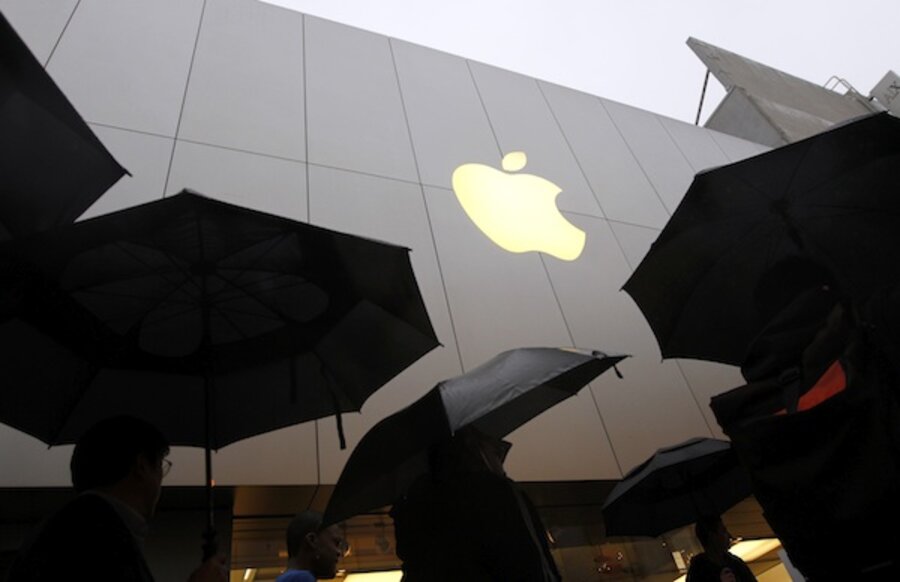Apple stock losses drag down the Nasdaq
Loading...
| New York
For most of the year, Apple stock has propelled the Nasdaq forward. In the past few days, it's done just the opposite.
The Nasdaq composite index, of which Apple accounts for 12 percent, was down Monday afternoon, dragged lower by Apple's fifth straight day of declines. That was a sharp contrast to the other two major indexes. The Dow Jones industrial average, which doesn't include Apple, rose throughout the day and was up 112 points in afternoon trading. The Standard & Poor's 500, which does include Apple but gives it a much lower weight than the Nasdaq does, wavered between small gains and losses.
Apple has been on a charmed run for the first three months of the year thanks to the huge popularity of its iPhones and iPads. From January through March the stock shot up 48 percent, to nearly $600 from $405, and drove the Nasdaq's 19 percent rise.
"It's been a very quirky market because it's been a few (big) companies that have delivered most of the rally this year," said Mark Lamkin, CEO of Lamkin Wealth Management in Louisville, Ky. "It's not been a broad-based rally."
The five-day losing streak is Apple's longest slump since October, but it's not clear if the recent decline is a short-term aberration or a sign of deeper problems. The company has been smoothing over allegations about poor working conditions at its factories in China. Phone companies are getting tired of subsidizing sales of the iPhone, which gets customers in the door but saps those companies' profit margins. The Department of Justice last week filed an antitrust lawsuit over the way it allegedly prices e-books. While that's not a huge part ofApple's business, it is a signal that the government has some qualms about Apple's dominance of all things "e."
Others think it's simply a matter of investors getting out because they're already made big money on Apple. Even after the five-day decline, which brought Apple's share price down from $636 to $586 as of Monday afternoon, the stock of the world's most valuable company is still up about 45 percent for the year.
"It's had a huge run," said Burt White, chief investment officer of LPL Financial in Boston. "Some investors probably said, 'Might as well take some profits.'"
Apple reports quarterly earnings on April 24.
Tech stocks fell the most of any group in the S&P 500, 3.6 percent. Utilities, consumer staples and financials all rose more than 2 percent.
Google, which makes up 3.5 percent of the Nasdaq composite index, was down for the second day in a row. The company went to trial Monday with Oracle, which accuses Google of copyright infringements related to its Android phone. Late Friday, the government fined Google for allegedly blocking an investigation into Google's data collection of street-level images for mapping.
Apple makes up more than 4 percent of the S&P 500. Along with IBM and Microsoft, it makes up more than 8 percent of the index, according to estimates by Sam Stovall, chief equity strategist of S&P Capital IQ. Stovall, who refers to a decline in Apple stock as "a Newtonian event," points out that that's the equivalent of the index's smallest 192 companies.
The Dow, which doesn't include Apple or Google, was up 0.9 percent at 12,961.
The Standard & Poor's 500 wavered between small gains and losses most of the day and was up four points at 1,374. The Nasdaq lost as much as 35 points and was down 15 points in the early afternoon to 2,996, below the closely watched 3,000 mark.
The Dow was driven higher by a stronger-than-expected report about March retail sales. The government reported that sales rose 0.8 percent in March compared to the previous month, twice was analysts had been expecting.
Skeptics noted that the results were still less than February's 1 percent increase, and they wondered if the results were a quirk of the mild winter, rather than a sign of recovery. The category that enjoyed the biggest jump was the seasonally-driven building materials, at 3 percent. Because people are buying lawn mowers and other warm-weather goods earlier in the year, that could mean those sales will soon peter out rather than provide the usual jump later in the spring.
"It's nice to see the retail sales were strong, but it's one month and it's one data point and it's not even the biggest data point," said Ryan Detrick, senior technical strategist at Schaeffer's Investment Research in Cincinnati. "Honestly, jobs are much more important."
Earlier this month, the government reported that the U.S. added only 120,000 jobs in March, about half the pace of the previous three months.
Signs that Europe's debt crisis could reignite have also hurt stocks. On Monday Spain's borrowing costs climbed above the closely watched 6 percent mark, which means investors are worried about the country's ability to pay its debts. Seven percent is usually considered the rate at which a country can no longer raise money. Sweden cuts its economic forecast for the year, saying that the euro zone's problems were spreading its way.
The yield on the 10-year Treasury note fell to 1.97 percent. That means investors are plowing money into government bonds, which they tend to do when they're nervous about the economy.







